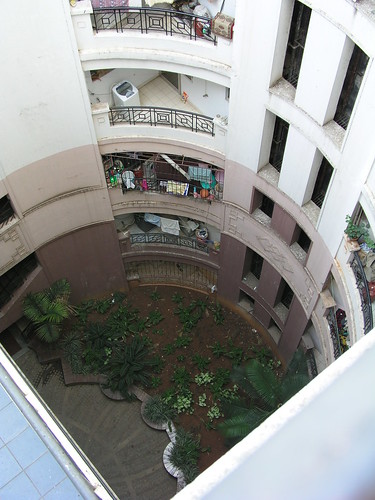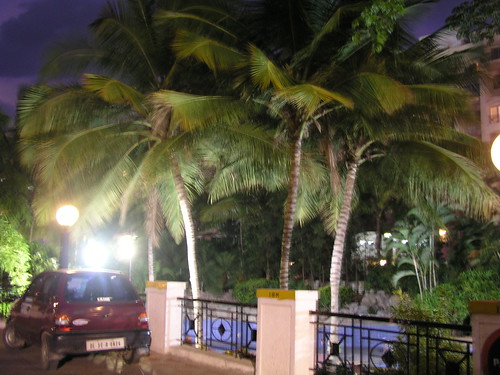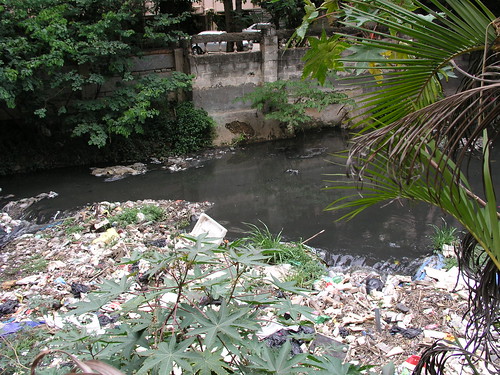The Diamond District is like a medieval walled city. It’s an irregular elliptical shape with five guarded gates; thee gates have little guardhouses. Two office buildings anchor one end of the complex and front on Old Airport Road (the road I came in on). Residential buildings make up the rest of the perimeter. Most of these buildings butt against each other with gaps only where there are driveways out to the gates. Service driveways of patterned, molded brick tile either run between the buildings and the external fences or they circle the interior park and play area. The interior driveway is also billed as a jogging track.
The interior and exterior driveways connect at each building through lovely arched passages with dramatic nighttime lighting; these passages give access to the building courtyards among other things. Each building is about seven or eight stories high in a uniform design of cream, peach and ochre stucco.

They are built on a general circle-in-square structure, so the central courtyard is round and the north/south or east/west "poles" are the location points for the elevators, stairways, and entrance points. Security guards sit at each entrance.
Seen through bleary 2 AM eyes; or at night from a distance, or from a balcony at sunset, with lights twinkling around the pool and palm trees rustling, the place seems just like the advertisement, exotic and even glamorous. But in the light of day, you also notice that the plaster and tile is cracked and crumbling in places; black dirt streaks the walls, especially within the courtyards; and there are always piles of sweepings or trash not-yet-picked-up and maintenance-in-progress going on somewhere.
The interior and exterior driveways connect at each building through lovely arched passages with dramatic nighttime lighting; these passages give access to the building courtyards among other things. Each building is about seven or eight stories high in a uniform design of cream, peach and ochre stucco.

They are built on a general circle-in-square structure, so the central courtyard is round and the north/south or east/west "poles" are the location points for the elevators, stairways, and entrance points. Security guards sit at each entrance.
Seen through bleary 2 AM eyes; or at night from a distance, or from a balcony at sunset, with lights twinkling around the pool and palm trees rustling, the place seems just like the advertisement, exotic and even glamorous. But in the light of day, you also notice that the plaster and tile is cracked and crumbling in places; black dirt streaks the walls, especially within the courtyards; and there are always piles of sweepings or trash not-yet-picked-up and maintenance-in-progress going on somewhere.

It's a mini-Bangalore. Something that went up fast when the economy was booming; progressive, convenient, a dream of good times and getting ahead but also stretched for resources to keep up.

I was especially astounded on my first walk when I stepped out onto the service drive behind my building and saw that a drainage canal ran along below the fence. It had serious swamp gas odor, water the color of milk chocolate, and banks littered with paper, plastics and old rags. That was a lot of trash floating downstream or snagged and bobbing in the water, too. Yet, on the other side of the canal was another apartment building and at the far end, buffered by some sort of service yard, was a very nice hotel and private golf course.
Back in the 1970s, the branches of the Chicago River used to be in pretty sad shape, a lot like this, but today, most people in Chicago who live along or near the river think of it as a picturesque feature. This canal was a real shock, like jumping backwards 30 or 40 or 50 years.

The office buildings, had their surprises, too. Especially the one that ThoughtWorks is not in. The ThoughtWorks building seems pretty full up with tenants and is on par with any Chicago class B commercial building but the other building seemed half deserted. It faces Airport Road directly and has the name “Diamond District” painted on the entrance in bold modern lettering. From the road, it looks like a cool place to be. The parking signs indicate that one of the major tenants is Oracle.
The far end of the building contains a medical clinic and a variety of doctor’s offices and seems in good shape. But here at the main entrance, peering into the lobby that first weekend, I saw the ceiling tiles had caved in, there was a pile of trash on the floor with plastic sheeting draped all around and lots of scaffolding.
A lonely guard sat at a desk and I would have tried for a few photos except I think he really didn’t want an Anglo-Euro type person documenting the situation. I came to the conclusion that another major tenant had pulled out or never came in, leaving half the place unfunded for maintenance. But that was three weeks ago and the lobby is repaired now and it seems to be a perfectly ordinary functional building.

I was especially astounded on my first walk when I stepped out onto the service drive behind my building and saw that a drainage canal ran along below the fence. It had serious swamp gas odor, water the color of milk chocolate, and banks littered with paper, plastics and old rags. That was a lot of trash floating downstream or snagged and bobbing in the water, too. Yet, on the other side of the canal was another apartment building and at the far end, buffered by some sort of service yard, was a very nice hotel and private golf course.
Back in the 1970s, the branches of the Chicago River used to be in pretty sad shape, a lot like this, but today, most people in Chicago who live along or near the river think of it as a picturesque feature. This canal was a real shock, like jumping backwards 30 or 40 or 50 years.

The office buildings, had their surprises, too. Especially the one that ThoughtWorks is not in. The ThoughtWorks building seems pretty full up with tenants and is on par with any Chicago class B commercial building but the other building seemed half deserted. It faces Airport Road directly and has the name “Diamond District” painted on the entrance in bold modern lettering. From the road, it looks like a cool place to be. The parking signs indicate that one of the major tenants is Oracle.
The far end of the building contains a medical clinic and a variety of doctor’s offices and seems in good shape. But here at the main entrance, peering into the lobby that first weekend, I saw the ceiling tiles had caved in, there was a pile of trash on the floor with plastic sheeting draped all around and lots of scaffolding.
A lonely guard sat at a desk and I would have tried for a few photos except I think he really didn’t want an Anglo-Euro type person documenting the situation. I came to the conclusion that another major tenant had pulled out or never came in, leaving half the place unfunded for maintenance. But that was three weeks ago and the lobby is repaired now and it seems to be a perfectly ordinary functional building.

I found one of the two grocery stores well, market as they call it, in the H block at the end of the complex. It has a lot in common with the small neighborhood stores you see in Chicago's black and Hispanic neighborhoods, except the lighting is dimmer and there's no alcohol. the shelves are packed with basics like bread, milk, cheese, eggs, chips and cookies, rice and pasta, toiletries, but nearly bare of fruits and vegetables. Household items in the back are jumbled up and dusty (they always are). No meat counter, either, hey, this is India. But there are some packages of cut-up chicken in the freezer. And the people are friendly and helpful.
I buy some things and continue to hunt for the other store. It's supposed to be in the N block but I don't see it. How can you hide a store? Oh, the guard tells me it's downstairs in the parking garage. Well, that's different! But it makes delivering the stock easy. This store is the one for fresh fruits and vegetables. It also has more specialty things like peanut butter, Green Giant corn and sweet pickles. There's a row of orders lined up on the floor for delivery to residents. I decide to try to split my shopping rupees as evenly as I can between the two places but I think this one is going to end up getting the bigger share.
The pots and pans in the kitchen are all sized for a family of four or more. I could use some smaller things. And maybe some knickknacks for those empty shadow boxes. Neither of these stores carries those things. Maybe I should get out beyond the walls tomorrow and do some other shopping.
Next: All about auto-rickshaws
I am not sure I got what you mean here
ReplyDelete"lot in common with the small neighborhood stores you see in Chicago's black and Hispanic neighborhoods.."
- Mayur, TW (Bangalore)
Those neighborhoods have a lot more independent, single-owner shops. Chicago neighborhoods are in grid patterns with four, six, or eight blocks of residential buildings bounded by commercial streets. There are lots of these little shops on the corners of the blocks and along the commercial streets so people only have to walk a short way to buy basic items. These are small shops, with narrow aisles and crowded for space. Shelving and furnishings in these stores tends to look handmade or is cobbled together from different places. They are a result of economics because large-scale chain grocery stores tended to avoid these neighorhoods as less profitable. That is changing now.
ReplyDeleteCool, thanks for the update :)
ReplyDeleteThank you given great information about my bright future at abroad. nice blog, it helpful blog.
ReplyDeleteJewelers Diamond District